In Maryland, six hummingbird species grace the skies, each with its unique charm and ecological significance.
The answer to the question of which hummingbirds inhabit Maryland reveals a diverse avian tapestry, from the common Ruby-throated Hummingbird to the occasional visitors like Rufous, Anna’s, Allen’s, Calliope, and Black-chinned.
These tiny, vibrant creatures play a crucial role in local ecosystems as pollinators and bring joy to observers with their iridescent plumage and aerial acrobatics.
This exploration will delve into the characteristics, behaviours, and conservation status of these six hummingbird species, offering a closer look at their lives in the charming landscapes of Maryland.
Join us in unravelling the secrets and wonders of these delightful birds that call Maryland home. So, stay sharp.
Common Features of Hummingbirds in Maryland
Hummingbirds in Maryland share several common features that characterize their biology, behaviour, and ecology.
These features contribute to their remarkable adaptability and unique role in ecosystems. Here are some common features of hummingbirds found in Maryland:
Small Size
Hummingbirds are among the smallest bird species, with lengths ranging from 2.8 to 4.3 inches. Their diminutive size allows them to easily access nectar from flowers and manoeuvre through dense vegetation.
Specialized Bill and Tongue
Hummingbirds have long, specialized bills adapted for feeding on flower nectar.
Their bills are slender and can open wide to allow them to probe deep into flowers. The tongue is extensible and has grooves to draw in nectar during feeding.
Iridescent Plumage
The plumage of hummingbirds often exhibits iridescence, appearing to change colour as the birds move.
This iridescence results from microscopic platelets in the feathers that refract light, creating vibrant hues, especially in sunlight.
Hovering Flight
Hummingbirds are unique in their ability to hover in mid-air by rapidly flapping their wings in a figure-eight pattern. This hovering capability is essential for accessing nectar from flowers and catching small insects.
Rapid Wing Beats
Hummingbirds have extremely fast wing beats, ranging from 50 to 80 beats per second, allowing them to hover, move backwards, and perform intricate aerial manoeuvres. This rapid wing movement is supported by powerful flight muscles.
High Metabolism
Hummingbirds have one of the highest metabolism rates among birds.
They need to consume large amounts of nectar to fuel their energy-demanding lifestyle. Some species can feed multiple times their body weight in a day.
Territorial Behavior
Hummingbirds exhibit territorial behaviour, especially during the breeding season.
Males are known to defend feeding territories aggressively, chasing away intruders, and engaging in aerial displays to attract mates.
Migration
Many hummingbird species found in Maryland are migratory. They undertake long journeys, often spanning thousands of miles, to reach their breeding and wintering grounds.
Ruby-throated Hummingbirds, for example, migrate across the Gulf of Mexico.
Clever Nests
Hummingbirds construct small cup-shaped nests using various materials such as plant fibres, spider silk, and down.
The nests are often camouflaged with lichen or other materials to blend into the environment and protect the eggs and chicks from predators.
Adaptation to Urban Environments
Some hummingbird species, like the Ruby-throated Hummingbird, have adapted well to urban and suburban environments.
They readily visit gardens and feeders, taking advantage of artificial food sources provided by humans.
These common features contribute to the uniqueness and charm of hummingbirds, making them a fascinating group of birds to observe and study in Maryland.
6 Hummingbirds in Maryland
Discover the vibrant world of hummingbirds in Maryland. From the iconic Ruby-throated to the elusive Calliope, each species brings its unique charm.
Explore their populations, lifespans, sizes, and more, unveiling the fascinating lifestyles of these enchanting birds in the Mid-Atlantic region.
1. Ruby-throated Hummingbird
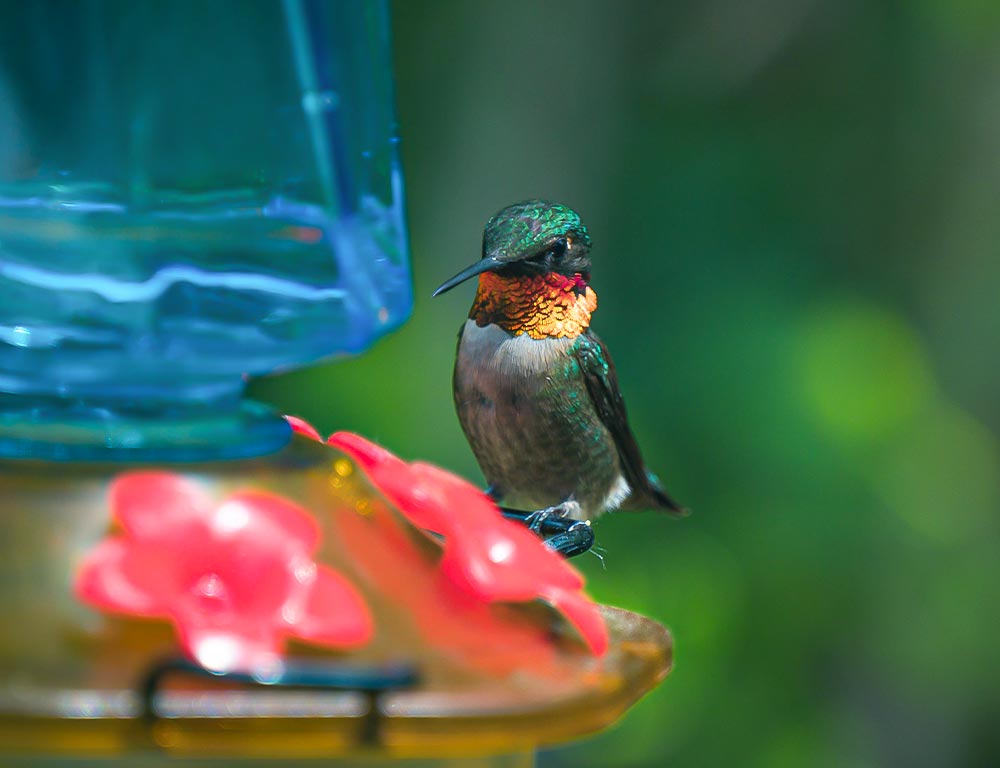
- Scientific Name: Archilochus colubris
- Population: Common, especially during migration
- Life Span: 3 to 5 years
- Size: 3 to 3.5 inches
- Weight: 2 to 20 grams
- Food: Nectar from flowers, small insects, and spiders
- Wingspan: 3 to 4 inches
- Status: Stable
The Ruby-throated Hummingbird is the only hummingbird species that breeds in eastern North America and is a common summer visitor to Maryland.
Known for their iridescent green plumage and the brilliant red throat of males, these birds are remarkable in flight, capable of hovering and performing rapid aerial manoeuvres.
They primarily feed on flower nectar using specialized bills and long tongues. Apart from nectar, they catch insects and spiders to supplement their protein intake.
Their small size and incredible agility make them an enchanting sight as they flit around flowers and feeders. Ruby-throated Hummingbirds are solitary and territorial, with males aggressively defending feeding territories.
During breeding, females build cup-shaped nests using plant fibres, spider silk, and other materials. After laying eggs, the female cares for the young alone.
These hummingbirds are known for their long migratory journeys, crossing the Gulf of Mexico to winter in Central America.
2. Rufous Hummingbird
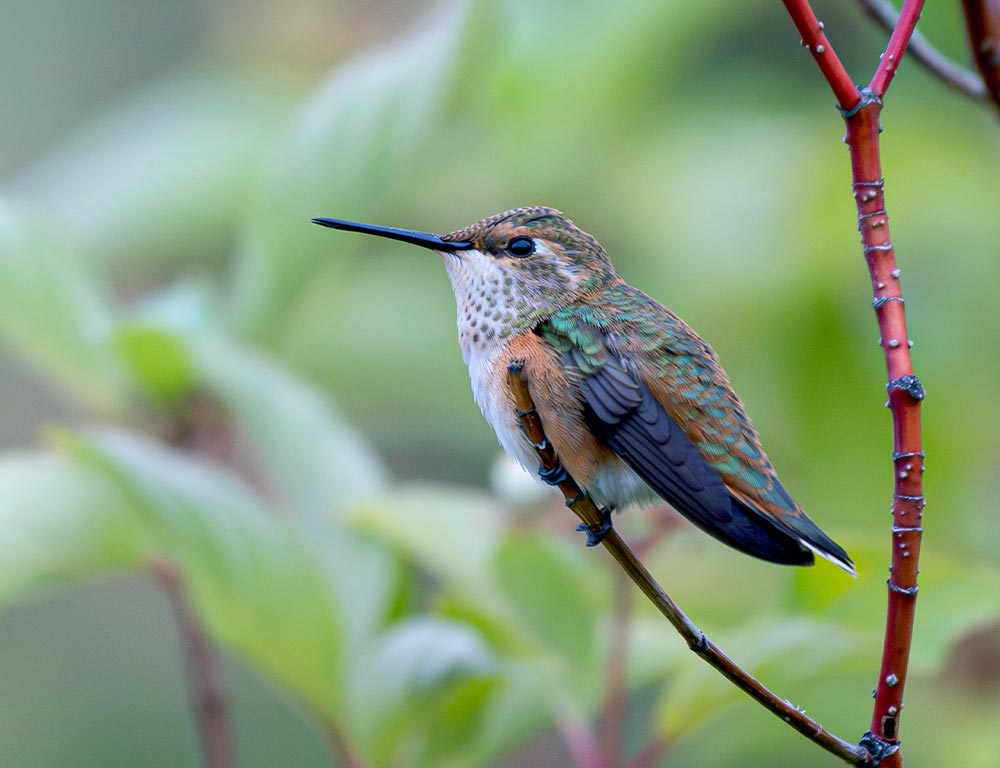
- Scientific Name: Selasphorus rufus
- Population: Uncommon, primarily seen during migration
- Life Span: 3 to 5 years
- Size: 3 to 4 inches
- Weight: 2 to 5.5 grams
- Food: Nectar, insects, and spiders
- Wingspan: 4 to 4.5 inches
- Status: Stable
The Rufous Hummingbird is a western species that occasionally visits Maryland during migration, making sightings less common.
They are known for their striking orange-red plumage and aggressive behaviour. Despite their small size, they are fearless defenders of feeding territories.
Rufous Hummingbirds have a diverse diet, feeding on nectar from various flowers and supplementing their nutrition with insects and spiders.
Their long migrations take them from their breeding grounds in western North America to wintering areas in Mexico and sometimes as far south as Central America.
These hummingbirds are highly adaptable and often found in various habitats, including gardens, meadows, and forests.
During breeding, females construct small cup-shaped nests using plant down, spider silk, and other materials. Like many hummingbirds, they are known for their aerial displays during courtship.
3. Black-chinned Hummingbird
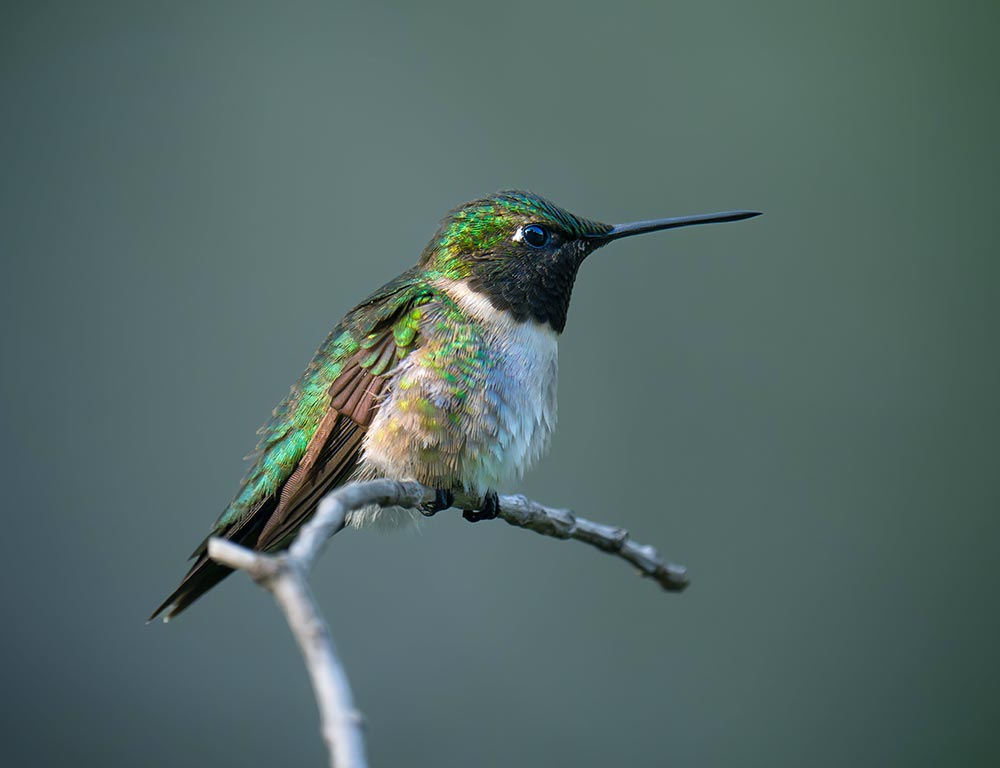
- Scientific Name: Archilochus alexandri
- Population: Rare in Maryland, with occasional sightings
- Life Span: 3 to 5 years
- Size: 3.5 to 4 inches
- Weight: 2 to 4 grams
- Food: Nectar, insects, and spiders
- Wingspan: 4 to 5 inches
- Status: Stable
The Black-chinned Hummingbird is a western species, and sightings in Maryland are infrequent. They are named for the black throat patch of males, which can be challenging to distinguish in the field.
These hummingbirds are agile fliers and, like others, are capable of impressive aerial displays during courtship.
Their diet consists mainly of nectar from various flowers, supplemented by insects and spiders for protein. They are known to be adaptable and may use a range of habitats, including arid and mountainous regions.
The female constructs a nest using plant fibres and spider silk, often placing it on a horizontal branch.
While not as well-studied as some other hummingbirds, the Black-chinned Hummingbird faces habitat loss and climate change threats. Conservation efforts focus on preserving their breeding and wintering habitats.
4. Anna’s Hummingbird
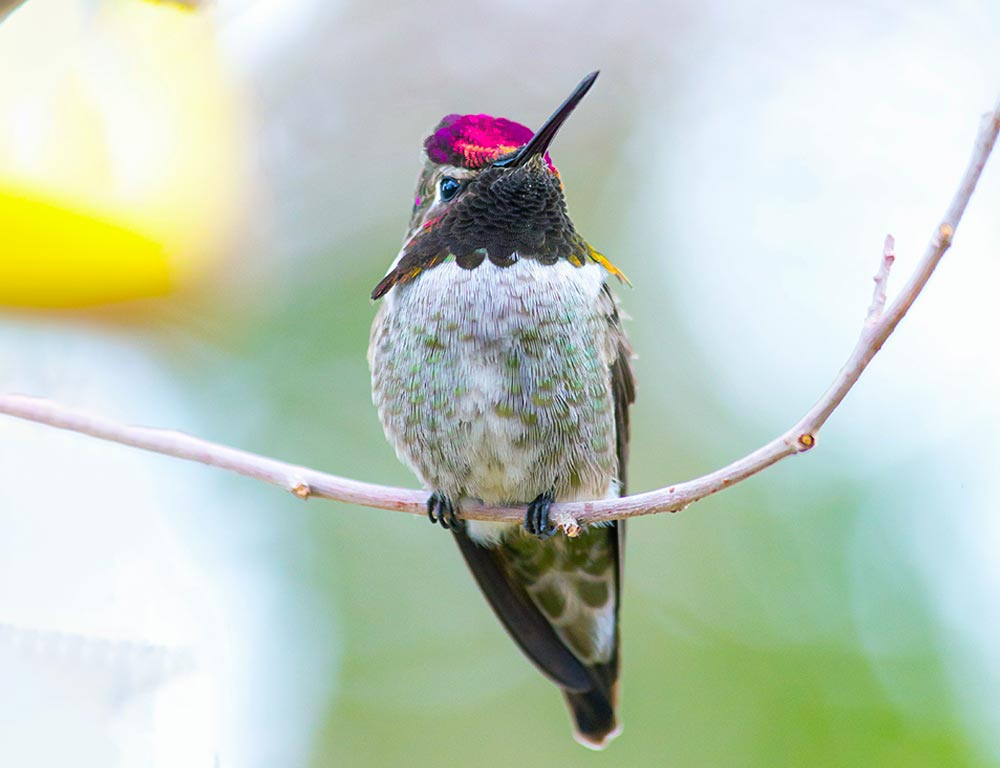
- Scientific Name: Calypte anna
- Population: Common in the western United States, becoming more prevalent in Maryland
- Life Span: 3 to 5 years
- Size: 3.9 to 4.3 inches
- Weight: 3.2 to 6 grams
- Food: Nectar, insects, and spiders
- Wingspan: 4 to 4.7 inches
- Status: Stable
Anna’s Hummingbird is a western species that has been expanding its range, and sightings in Maryland are becoming more frequent.
Named after Anna Massena, the Duchess of Rivoli, they are known for their vibrant magenta crown and throat feathers.
These hummingbirds are year-round residents in some parts of their range, including the United States West Coast. They feed on flower nectar, insects, and spiders using their specialized bills and long tongues.
Unlike many other hummingbird species, Anna’s Hummingbirds are known for their ability to survive in colder temperatures, often seen foraging in gardens even during winter.
Males engage in spectacular courtship displays involving steep dives and high-speed chases. Females build cup-shaped nests using plant fibers, spider silk, and other materials, placing them in trees or shrubs.
Conservation efforts focus on providing suitable habitat and food sources, especially during winter when natural food availability may be limited.
5. Allen’s Hummingbird
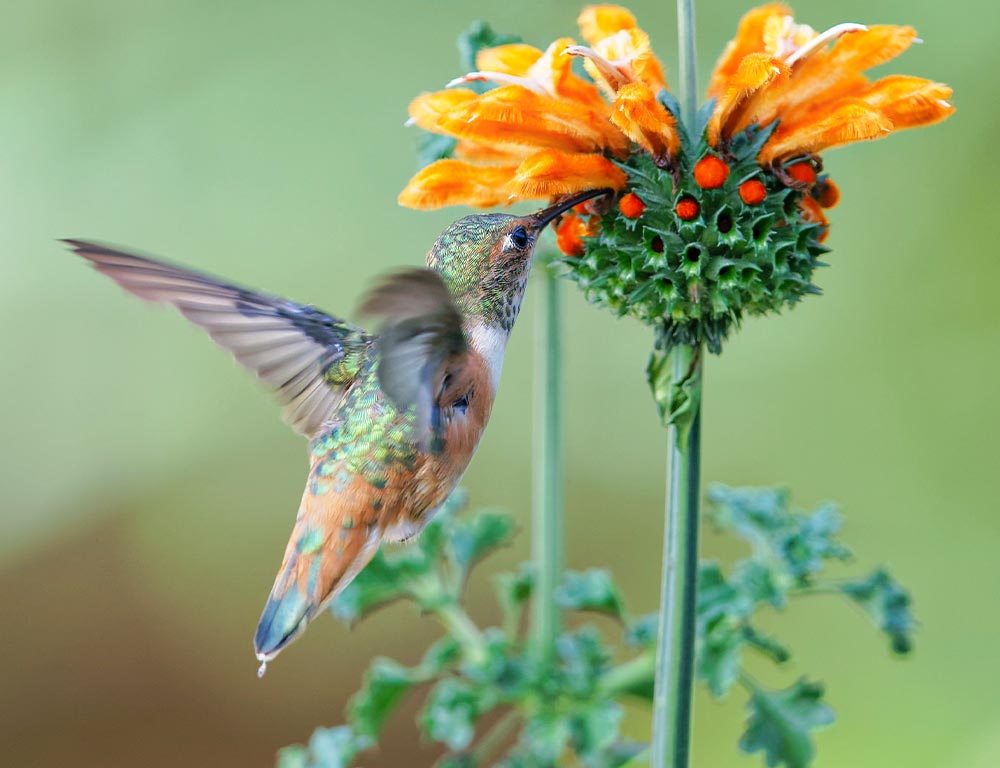
- Scientific Name: Selasphorus sasin
- Population: Common along the West Coast, rare in Maryland
- Life Span: 3 to 5 years
- Size: 3.5 to 4 inches
- Weight: 2 to 5 grams
- Food: Nectar, insects, and spiders
- Wingspan: 4 to 4.5 inches
- Status: Stable
Allen’s Hummingbird is closely related to the Rufous Hummingbird and is primarily found along the West Coast. While they are rare in Maryland, occasional sightings occur during migration.
Males have vibrant orange-red throat feathers, and their colouring can be similar to the Rufous Hummingbird, making identification challenging. They feed on nectar from various flowers, supplemented by insects and spiders.
Like other hummingbirds, they are agile fliers and engage in aerial displays during courtship. Females construct small cup-shaped nests in shrubs or trees, using plant fibers, down, and spider silk.
Conservation efforts for Allen’s Hummingbird often overlap with those for other western hummingbird species. Protecting their breeding habitats and migration routes is crucial for the long-term survival of these beautiful birds.
6. Calliope Hummingbird
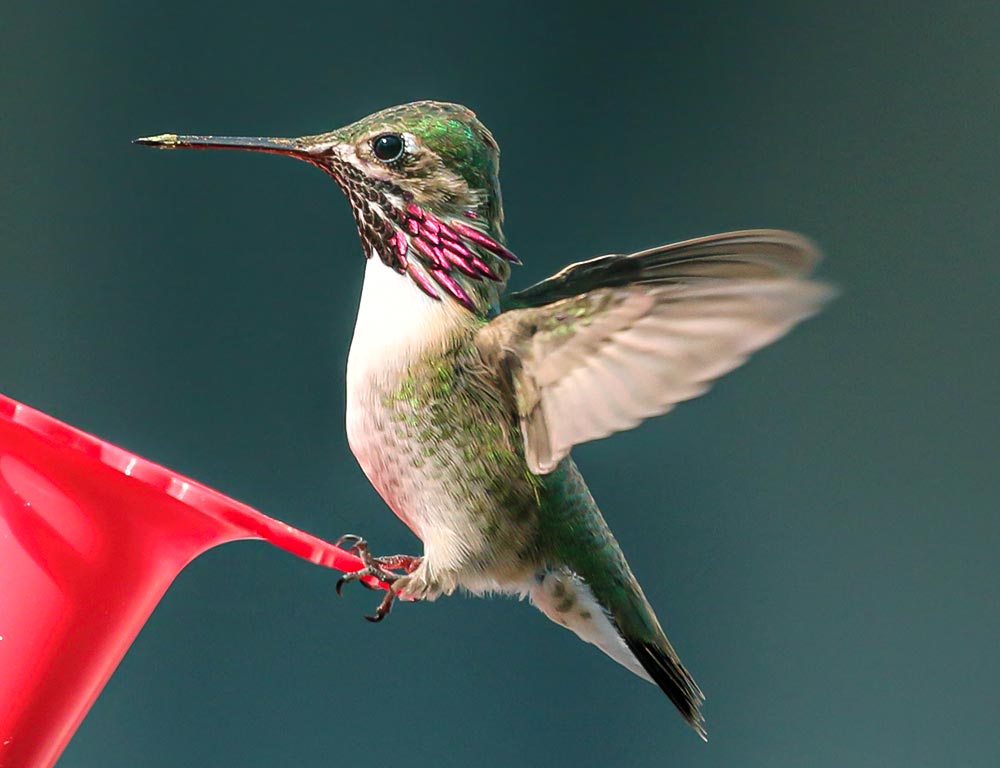
- Scientific Name: Selasphorus calliope
- Population: Rare, occasional sightings in Maryland
- Life Span: 3 to 5 years
- Size: 2.8 to 3.5 inches
- Weight: 2 to 4 grams
- Food: Nectar, insects, and spiders
- Wingspan: 3.1 to 4 inches
- Status: Stable
The Calliope Hummingbird is the smallest bird species in North America. While it is primarily found in the western United States, sightings in Maryland are rare.
Named after the Greek muse Calliope, these hummingbirds have distinctively long and pointed tail feathers. They feed on nectar from a variety of flowers, supplemented with insects and spiders.
Like other hummingbirds, they are highly agile and capable of rapid flight. Males engage in impressive aerial displays during courtship, often involving steep climbs and dives.
Females construct small, cup-shaped nests using plant fibres, down, and spider silk, typically placing them on horizontal branches.
Conservation efforts for the Calliope Hummingbirds focus on understanding their migration patterns and protecting their breeding and wintering habitats in the western United States.
Necessary Steps to Preserve Hummingbirds in Maryland
Preserving hummingbirds in Maryland involves a combination of habitat conservation, public awareness, and responsible practices.
Here are some of the key steps to help preserve these fascinating birds in the state:
Habitat Preservation and Restoration
- Native Plant Promotion: Encourage planting native flowering plants that provide nectar for hummingbirds. This helps create suitable habitats and ensures a natural, diverse food source.
- Protection of Natural Spaces: Advocate for the preservation and restoration of natural areas, such as meadows, woodlands, and gardens, which serve as crucial habitats for hummingbirds.
Education and Public Awareness
- Community Outreach Programs: Organize educational programs, workshops, and outreach initiatives to raise awareness about hummingbirds, their ecological importance, and the threats they face.
- School Curriculum Integration: Work with educational institutions to integrate hummingbird ecology into school curricula, fostering a sense of responsibility and appreciation for these birds among the younger generation.
Responsible Feeding Practices
- Hummingbird Feeder Maintenance: Encourage proper cleaning and maintenance of hummingbird feeders to prevent the spread of diseases. Regularly clean feeders with a solution of one part sugar to four parts water and avoid using harmful chemicals.
- Limiting Red Dye Usage: Discourage the use of red food dye in hummingbird feeders, as it may be harmful to the birds. Emphasize the importance of providing a clean and safe environment for hummingbirds to feed.
Mitigation of Climate Change Impact
- Advocacy for Climate Action: Support initiatives and policies aimed at addressing climate change, as shifts in temperature and precipitation patterns can affect the availability of suitable habitats and food sources for hummingbirds.
- Promotion of Sustainable Practices: Encourage practices that reduce carbon emissions, such as energy conservation, sustainable agriculture, and the use of renewable energy sources.
Research and Monitoring Programs
- Citizen Science Initiatives: Promote citizen science programs where individuals can contribute observations and data on hummingbird sightings. This data can be valuable for monitoring population trends and understanding migration patterns.
- Collaboration with Research Institutions: Support and collaborate with research institutions to conduct studies on hummingbird behaviour, migration, and ecology. This scientific knowledge can inform conservation strategies and policies.
Legislation and Regulation
- Habitat Protection Laws: Advocate for and support legislation that protects hummingbird habitats, including regulations on land development and urban planning to ensure the preservation of essential foraging and nesting areas.
- Pesticide Control Measures: Work towards implementing and enforcing regulations that limit the use of pesticides harmful to hummingbirds, as these chemicals can impact their food sources and overall health.
By implementing these measures, Maryland can contribute to the conservation of hummingbirds, ensuring their presence for future generations to enjoy and appreciate.
Wrapping Up
In the vibrant landscapes of Maryland, hummingbirds bring an enchanting touch with their iridescence, rapid flights, and delicate hovering.
From the common Ruby-throated Hummingbird to the occasional visitors like Allen’s and Calliope, these tiny avian wonders share a set of remarkable features.
Their small size, specialized bills, and territorial behaviours highlight their unique adaptations. Maryland’s efforts to preserve hummingbirds involve habitat conservation, responsible feeding practices, and fostering public awareness.
By advocating for native plants, educating communities, and supporting research initiatives, we contribute to the conservation of these charismatic birds.
As we marvel at their iridescent plumage and agile flights, let’s collectively work towards sustaining the hummingbird populations in Maryland for generations to come. Best of luck.